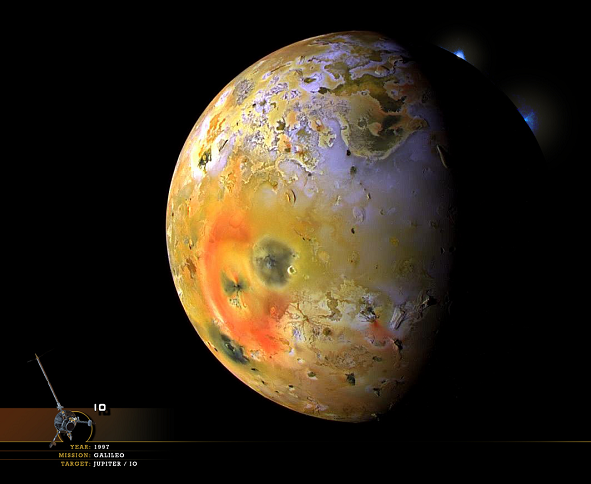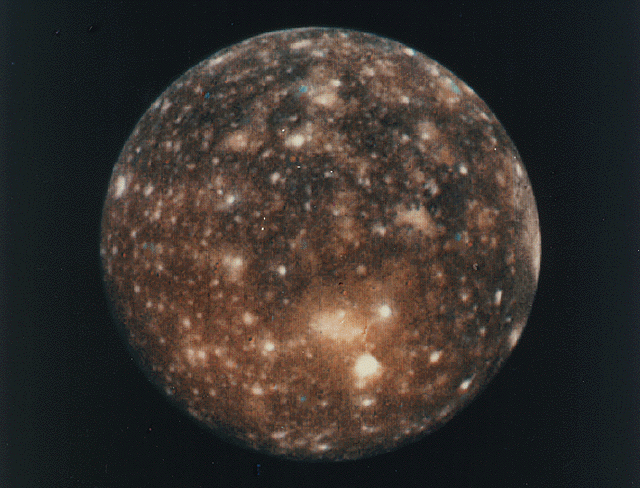Introduction
Jupiter has always attracted a lot of attention due to its rings and numerous satellites. The most famous and the first satellites that were discovered are Io, Callisto, Europa and Ganymede. Some researchers even note that these satellites can be seen as “a kind of miniature solar system orbiting Jupiter” (Elkins-Tanton 60). It is noteworthy that all the moons of Jupiter keep one face towards the planet just as the Moon does not revolve. Galileo used his telescope to observe Jupiter and discovered the four moons on January 7, 1610 (McAnally 91). Clearly, these four satellites were called Galilean moons. Importantly, observation of these moons’ orbits helped researchers measure the speed of light (Elkins-Tanton 61). Of course, the satellites helped understand many secrets of the universe. More so, one of these moons is seen as potentially appropriate for human life. It is possible to focus on Io and Callisto as they have more secrets and interesting answers than the rest of Jupiter’s satellites.
Naming the Moons
Interestingly, Galileo did not give the names to the moons he discovered. Galileo simply gave numbers to the satellites. Thus, Io was primarily known as Jupiter I and Callisto was known as Jupiter VI. Simon Marius (1573-1624) claimed he discovered the satellites simultaneously with Galileo, but since Galileo was the first one to publicize his discovery, Marius failed to prove he was the first one (Young 20).
The moons got the names of lovers of Jupiter, Io and Callisto. However, these names were forgotten and they came in use only in the 19th century. Now, the four major satellites are known Io, Callisto, Europa and Ganymede, famous characters of the Greek and Roman mythology.
Io
As it is clear from Galilean name, Io is the closes satellite to the planet. In the first place, it is necessary to note that this moon’s mass and density are very similar to those of the Moon (Lissauer and De Pater 260). It is also clear that Io’s surface is very young only a few million years. The satellite’s diameter is 3,631 km and it orbits Jupiter at the distance of more than 421,000 km (Young 20).

Io is very unique due to its high volcanic activity. There are around 400 volcanoes on Io. All the volcanoes are active. It is noteworthy that Io can be regarded as a “major polluter of the Jovian environment” as the moon develops clouds of neutral atoms and spreads deposits sulfur and dust on the surface of other satellites (McAnally 92). The moon has certain atmosphere that consists of gaseous sulfur and oxygen. However, the proportions of the gases are very changeable as the volcanoes erupt and emit one ton of gases every second but these gases go into space due to the moon’s “low escape velocity” (Seeds and Backman 514).
As for the surface of the moon it is very specific. There are enormous volcanoes and mountains (some of them are very tall). The volcanic activity accounts for the abundance of sulfur and sulfur dioxide. It is necessary to note that sulfur dioxide (which is a gas on the Earth) can take any form on Io and it can be a gas, solid or “a subsurface liquid” (Koupelis 252). This is the reason why the moon’s surface is constantly changing. The mix of the elements mentioned above also creates a very specific color of Io’s surface that can range from bright orange to pale yellow as well as green and blue (see fig. 1).
Another peculiarity of the satellite is that lava flows at such high temperature as 1800 K, which is 1/3 the temperature of the Sun (although it is known that sulfur evaporates ate significantly lower temperatures 700 K). Researchers note that Io can reveal many secrets of the history of the Earth as volcanoes on the Earth’s surface about 2 million years ago were as hot as they are now on Io (Koupelis 253). The satellite is predominantly rocky with no traces of water or ice. More so, Io is the driest body in the solar system (Seeds and Backman 514). Therefore, it is unlikely to become appropriate for human life.
Io was a subject of extensive research and a number of expeditions were launched. Thus, the Voyager and the Galileo were important expeditions that helped identify composition of the moon’s atmosphere and surface. The observation is still taking place and scientists observe the satellite with the help of numerous telescopes.
Callisto
Callisto is the second largest moon of Jupiter. The diameter of Callisto is 4,801km and it is approximately equal to Mercury (in size). At the same time, the moon is only third of Mercury’s mass. The satellite orbits the planet at the distance of 1,883,000 km (Young 19). The satellite is tidal locked to Jupiter and it keeps one side to the planet. Callisto is a mixture of ice and rock (and these two elements make up almost equal parts in the satellite), which leads to a specific color of the planet. The planet is grey due to the dusty crust that is created by chemical reactions caused by radiation and dust from meteorite impacts (Seeds and Backman 511). The compounds found on the satellite are carbon, dioxide, water, silicates and some organic compounds (see fig. 2). The surface of the moon is covered with numerous impact craters. Interestingly, the moon is the most cratered object in the solar system (Koupelis 255). The largest impact crater of Callisto is called Valhalla, which is 600 km in diameter (Young 20). It is noteworthy that due to low tidal heating the surface of the satellite is inactive. The crust of Callisto is approximately 4 billion years. The satellite is also one of the oldest objects in the solar system.
Interestingly, analysis of the gravitational field led to the assumption that there is not “a dense core and a lower-density mantle” (Seeds and Backman 511). It is noteworthy that Callisto is the largest object (which is not fully differentiated) in the solar system. The satellite consists of different layers of rocks and ice. It is also clear that the moon has a weak magnetic field. The moon has a very thin atmosphere that mainly consists of carbon dioxide, particle of oxygen and some ionosphere.

Importantly, the moon is seen as potentially appropriate for human life as there is a lot of ice. More so, it has been found that the satellite must have a layer of salty water. It is approximately 100 km below the surface of the moon. The radiation will ensure the necessary heat that will prevent the waters from freezing. It is necessary to note that there were numerous expeditions to Callisto. One of the most successful ones was Galileo. The spacecraft sent by NASA recorded numerous valuable data including atmospheric composition. This was the expedition that helped researchers hypothesize that there is a layer of salty water below the surface of Callisto.
An Important Mission to Jupiter
It is necessary to add that there is an important mission that has recently been launched, Juno. The spacecraft developed by scientists coming from many countries has been sent to Jupiter and its satellites (“The Journey to Jupiter”). The researchers expect to learn more about the planet’s formation and its origins. The spacecraft will collect data and samples from the planet and its satellites. This robotic spacecraft will make photos and carry out numerous tests. This will also help researchers understand the way the Earth developed and the reasons why water is on our planet in such abundance.
Conclusion
On balance, it is possible to note that Jupiter’s moons Io and Callisto have revealed many secrets of the solar system. Analysis of these satellites’ composition and surface has helped to understand the way planets were formed. It is noteworthy that researchers consider each object of the solar system in terms of its qualities that can be favorable for organic life. Callisto has proved to be quite appropriate for human life. It is possible that someday the two moons will help researchers answer all their questions concerning the past, present and the future of the solar system and the human within it.
Works Cited
Elkins-Tanton, Linda T. Jupiter and Saturn. New York: Infobase Publishing, 2009. Print.
Koupelis, Theo. In Quest of the Universe. Burlington: Jones & Bartlett Publishers, 2012. Print.
Lissauer, Jack J., and Imke De Pater. Fundamental Planetary Science: Physics, Chemistry and Habitability. New York: Cambridge University Press, 2013. Print.
McAnally, John W. Jupiter: And How to Observe It. New York: Springer Science & Business Media, 2007. Print.
The Journey to Jupiter. Web. 2014.
Seeds, Michael, and Dana Backman. The Solar System. Boston: Cengage Learning, 2012. Print.
Young, Abby. Jupiter. New York: The Rosen Publishing Group, 2005. Print.